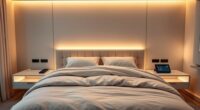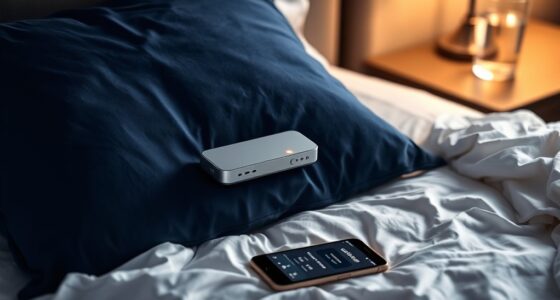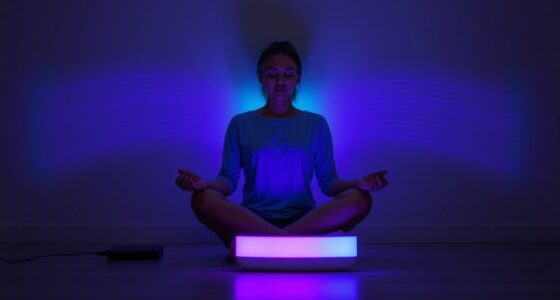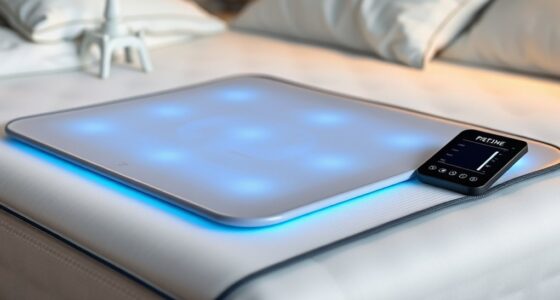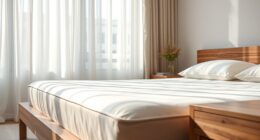Using wearable sleep trackers means you’ll wear a device on your wrist, giving you continuous data on movements and heart rate, but they might miss detailed sleep stages. Bedside monitors sit under or on your mattress, offering more stable and direct measurements, though they can be affected by mattress type. Each has pros and cons, so understanding their differences helps, and if you keep exploring, you’ll discover how to choose the best option for your needs.
Key Takeaways
- Wearables are convenient for continuous tracking but may lack detailed sleep stage accuracy compared to bedside monitors.
- Bedside monitors typically provide more stable and consistent sleep data through direct physiological signals.
- Wearables require ongoing wear and may misinterpret restless or light sleep; bedside devices are non-intrusive but less detailed.
- Both devices offer useful trend data but are less precise than clinical sleep studies for diagnosing sleep disorders.
- Choice depends on desired convenience versus the need for more accurate, stable sleep quality assessments.
When it comes to monitoring your sleep, choosing between wearable sleep trackers and bedside monitors can be confusing. Both options aim to give you insights into your sleep patterns, but they do so in different ways, which can impact how you perceive your sleep quality and the accuracy of the data collected. Understanding these differences helps you decide which device best fits your needs.
Choosing between wearable sleep trackers and bedside monitors depends on your need for convenience versus accuracy.
Wearable sleep trackers sit comfortably on your wrist or another part of your body, tracking movements and sometimes heart rate or even blood oxygen levels. Because they are worn throughout the night, they provide continuous data that can reveal patterns over time. However, while these devices are convenient and easy to use, their data accuracy can vary. Movement-based tracking may misinterpret restless nights, periods of wakefulness, or light sleep stages, leading to less precise measurements of your sleep quality. If you’re seeking highly detailed and accurate data, especially about specific sleep stages, some wearables might fall short, but they can still offer valuable trend information.
On the other hand, bedside monitors typically use sensors placed on your mattress or under your pillow to detect movement, breathing, and sometimes heart rate. These devices tend to be less intrusive since you don’t need to wear anything, and they often provide a more stable, consistent data stream. Because they analyze physiological signals more directly, they can sometimes deliver more accurate assessments of sleep quality, particularly in measuring sleep duration and detecting disturbances. That said, their accuracy can be influenced by factors like mattress type or placement, and they might not capture as much detail about sleep stages compared to clinical sleep studies.
Additionally, recent advancements in sleep tracking technology are aiming to improve the precision of consumer devices, but it’s important to recognize current limitations. Ultimately, your choice depends on what you value most. If you want a simple, user-friendly way to track overall sleep trends without disrupting your nightly routine, a wearable might be suitable. But if you’re concerned about data accuracy and want a device that offers a more exhaustive picture of your sleep health, a bedside monitor could be a better fit. Keep in mind that no consumer device offers perfect accuracy, and for serious sleep issues, consulting a healthcare professional or undergoing a sleep study is always recommended. Both options, however, can help you become more aware of your sleep habits and motivate you to make healthier choices for better sleep quality.
Frequently Asked Questions
How Accurate Are Wearable Sleep Trackers Compared to Clinical Sleep Studies?
You might wonder how accurate your sleep tracker is compared to clinical sleep studies. While wearables can estimate your sleep cycle and monitor movements, their accuracy depends on device calibration and algorithms. They’re useful for tracking trends but often fall short of the detailed data from sleep studies. For precise diagnosis, a clinical sleep study remains the gold standard, as it captures extensive sleep patterns beyond wearable device capabilities.
Can Bedside Monitors Detect Sleep Disorders More Effectively Than Wearables?
Detecting sleep disorders effectively involves evaluating clinical diagnostics and patient comfort equally. Bedside monitors excel here—they provide thorough data, identify irregularities, and often match clinical standards. Unlike wearables, bedside monitors don’t rely on user compliance and offer continuous, accurate monitoring. You benefit from enhanced diagnostics and comfort, as these monitors are designed for detailed analysis without disrupting your sleep, making them a more effective choice for detecting sleep disorders.
Are Wearable Devices Suitable for Children or Elderly Individuals?
You should consider that wearable devices can be suitable for children and elderly individuals, especially for child safety and elderly monitoring. They’re non-intrusive, easy to wear, and provide continuous data, helping you track sleep patterns and detect issues early. However, make certain the device is comfortable and safe for extended use. Always check for age-appropriate features and consult with healthcare professionals to choose the best option for your loved ones.
Do Environmental Factors Affect the Performance of Bedside Sleep Monitors?
Environmental factors, like ambient interference, can definitely impact bedside sleep monitors’ accuracy. You should pay attention to device placement; placing the monitor away from electronic devices, windows, or sources of noise helps reduce interference. These factors can cause false readings or missed data, so optimizing your environment enhances monitor performance. Keep your sleep area calm and clutter-free to ensure reliable tracking and better sleep insights.
What Is the Cost Difference Between Wearable Trackers and Bedside Monitoring Systems?
When comparing costs, you’ll find that wearable sleep trackers are generally more affordable than bedside monitoring systems. Wearables often cost between $50 and $300, making them accessible for personal use. Bedside monitors, however, can range from several hundred to thousands of dollars, depending on features and complexity. An affordability analysis shows wearables are budget-friendly options, while bedside systems offer more detailed data at a higher price point.
Conclusion
Ultimately, whether you lean towards wearable sleep trackers or bedside monitors, each option offers a gentle nudge toward better rest. Think of them as friendly guides, helping you discover your sleep rhythms without fuss. Embrace the tool that fits your lifestyle, and let it softly steer you toward sweeter dreams. After all, a good night’s sleep isn’t about perfection, but about finding what feels right for you and making it a cozy part of your routine.

